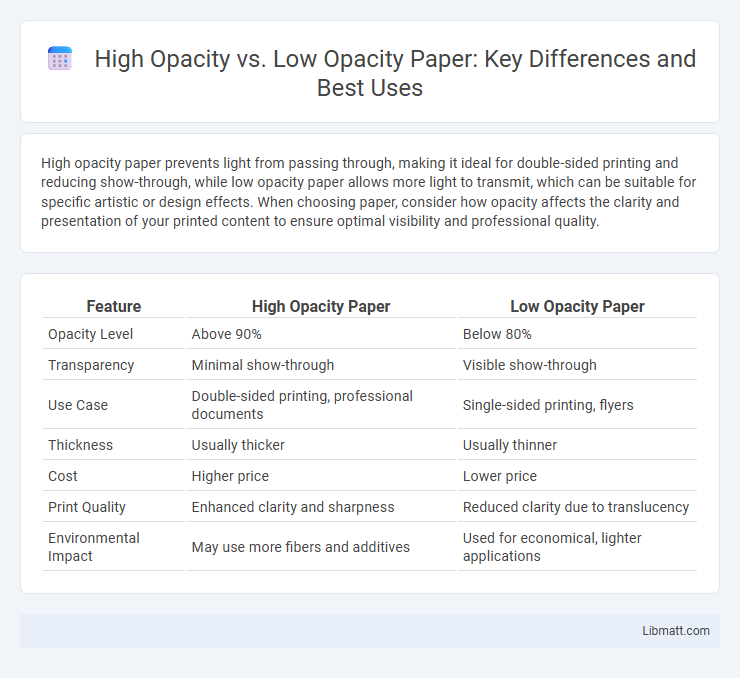High opacity paper prevents light from passing through, making it ideal for double-sided printing and reducing show-through, while low opacity paper allows more light to transmit, which can be suitable for specific artistic or design effects. When choosing paper, consider how opacity affects the clarity and presentation of your printed content to ensure optimal visibility and professional quality.
Table of Comparison
| Feature | High Opacity Paper | Low Opacity Paper |
|---|---|---|
| Opacity Level | Above 90% | Below 80% |
| Transparency | Minimal show-through | Visible show-through |
| Use Case | Double-sided printing, professional documents | Single-sided printing, flyers |
| Thickness | Usually thicker | Usually thinner |
| Cost | Higher price | Lower price |
| Print Quality | Enhanced clarity and sharpness | Reduced clarity due to translucency |
| Environmental Impact | May use more fibers and additives | Used for economical, lighter applications |
Understanding Paper Opacity: Definition and Importance
Paper opacity measures the degree to which paper prevents light from passing through, influencing print quality and readability. High opacity paper minimizes show-through and bleed-through, making it ideal for double-sided printing and professional documents. Low opacity paper allows more light transmission, often used for tracing or artistic purposes where translucency is required.
High Opacity Paper: Key Features and Benefits
High opacity paper prevents show-through and bleed-through, ensuring crisp, clear printing on both sides, which is essential for double-sided documents and professional presentations. Its dense fibers reduce light transmission, providing enhanced readability and a more substantial feel. This paper type improves print quality for detailed graphics, making it ideal for brochures, textbooks, and marketing materials.
Low Opacity Paper: Characteristics and Uses
Low opacity paper is characterized by its translucency, allowing light to pass through easily, which often results in text or images showing through from the reverse side. Commonly used in packaging, tracing, and specialty printing, this paper type enhances visual effects while being lightweight and cost-effective. Your choice of low opacity paper can optimize printing creativity but may require careful handling to avoid bleed-through and maintain readability.
Comparing High vs Low Opacity Paper
High opacity paper prevents text and images from showing through the opposite side, enhancing readability and print quality, especially in double-sided printing. Low opacity paper allows more light to pass through, making it more translucent but less ideal for documents requiring clear, crisp visuals. Choosing high opacity paper is essential for professional presentations, textbooks, and brochures where clarity and permanence are priorities.
Impact of Opacity on Print Quality
High opacity paper minimizes show-through and improves print clarity by preventing ink from bleeding through the sheet, ensuring vibrant colors and sharp text. Low opacity paper allows more light to pass through, which can result in visible bleed-through and reduced print sharpness, negatively affecting overall print quality. Selecting high opacity paper is essential for professional printing projects where image fidelity and readability are critical.
Applications Suited for High Opacity Paper
High opacity paper is ideal for applications requiring minimal show-through and enhanced readability, such as double-sided printing in books, magazines, and brochures. It is preferred for high-quality marketing materials and professional reports that demand crisp, clear text on both sides. Packaging and labels also benefit from high opacity paper to maintain visual clarity and product presentation.
When to Choose Low Opacity Paper
Low opacity paper is ideal when you want to reduce show-through and improve readability in double-sided printing, making it perfect for textbooks, manuals, and brochures. Its translucency allows for clear visibility of printed content on both sides without distracting bleed-through, enhancing the overall quality of your documents. Choose low opacity paper to ensure your printed materials maintain sharp contrast and professional appearance, especially in densely printed or detailed layouts.
Factors Influencing Paper Opacity
Paper opacity is primarily influenced by the fiber composition, filler content, and the degree of refining during pulp processing. High opacity papers typically contain higher percentages of fillers like calcium carbonate and titanium dioxide, which scatter light more effectively, reducing transparency. The paper's thickness and coating also play significant roles, with thicker and more heavily coated sheets exhibiting greater opacity due to increased light scattering and absorption.
Cost Considerations: High vs Low Opacity Paper
High opacity paper generally costs more due to the higher quality fibers and additional processing required to minimize light transmission and prevent show-through, making it ideal for double-sided printing and professional presentations. Low opacity paper is less expensive, often produced with fewer or lower quality fibers, which allows more light to pass through, resulting in potential bleed-through on printed materials but serving well for everyday, less formal uses. Choosing between high and low opacity paper depends on budget constraints, print quality requirements, and the nature of the final product's use.
Choosing the Right Opacity for Printing Needs
High opacity paper prevents show-through, ensuring your printed text and images remain crisp and clear, which is essential for double-sided printing and professional presentations. Low opacity paper may be more cost-effective but can result in visible bleed-through, reducing readability and overall print quality. Choosing the right opacity for your printing needs depends on the importance of print clarity, paper weight, and the type of printer you use to achieve the best results for your projects.
high opacity vs low opacity paper Infographic

 libmatt.com
libmatt.com